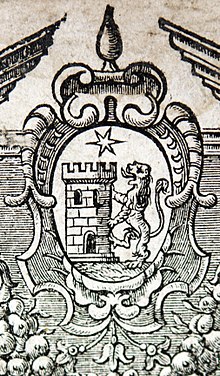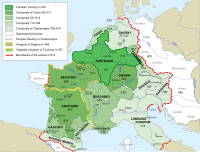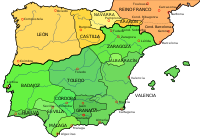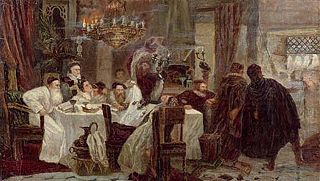
Marranos is one of the terms used in relation to Spanish and Portuguese Jews who converted or were forced by the Spanish and Portuguese crowns to convert to Christianity during the fifteenth and sixteenth centuries, but continued to practice Judaism in secrecy or were suspected of it, referred to as Crypto-Jews. "Crypto-Jew" is the term increasingly preferred in scholarly works, instead of Marrano.
The golden age of Jewish culture in Spain, which coincided with the Middle Ages in Europe, was a period of Muslim rule during which, intermittently, Jews were generally accepted in society and Jewish religious, cultural, and economic life flourished.

Hasdai ben Abraham Crescas was a Spanish-Jewish philosopher and a renowned halakhist. Along with Maimonides ("Rambam"), Gersonides ("Ralbag"), and Joseph Albo, he is known as one of the major practitioners of the rationalist approach to Jewish philosophy.

The Abravanel family, also spelled as Abarbanel, Abrabanel, Avravanel, Barbernell, or Barbanel – literally meaning Ab ("father") rabban ("priest") el – is one of the oldest and most distinguished Jewish families. It first achieved prominence on the Iberian peninsula during the Middle Ages. Its members claim to trace their origin to the biblical King David. Members of this family lived in Seville, Córdoba, Castile-Leon, and Calatayud. Seville is where its most prominent representative, Don Judah Abravanel, once dwelt.
Joseph Nasi, known in Portuguese as João Miques, was a Portuguese Sephardi diplomat and administrator, member of the House of Mendes/Benveniste, nephew of Dona Gracia Mendes Nasi, and an influential figure in the Ottoman Empire during the rules of both Sultan Suleiman I and his son Selim II. He was a great benefactor of the Jewish people.
Spanish and Portuguese Jews, also called Western Sephardim, Iberian Jews, or Peninsular Jews, are a distinctive sub-group of Sephardic Jews who are largely descended from Jews who lived as New Christians in the Iberian Peninsula during the few centuries following the forced expulsion of unconverted Jews from Spain in 1492 and from Portugal in 1497. They should therefore be distinguished both from the descendants of those expelled in 1492 and from the present-day Jewish communities of Spain and Portugal.
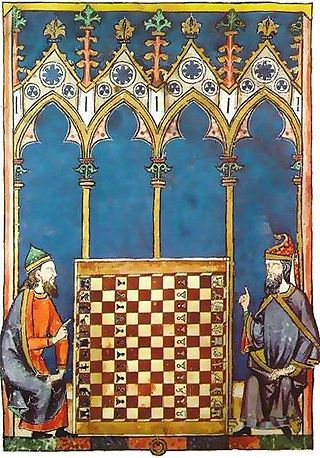
The history of the Jews in the current-day Spanish territory stretches back to Biblical times according to Jewish tradition, but the settlement of organised Jewish communities in the Iberian Peninsula possibly traces back to the times after the destruction of the Second Temple in 70 CE. The earliest archaeological evidence of Hebrew presence in Iberia consists of a 2nd-century gravestone found in Mérida. From the late 6th century onward, following the Visigothic monarchs' conversion from Arianism to the Nicene Creed, conditions for Jews in Iberia considerably worsened.

Gracia Mendes Nasi, also known as Doña Gracia or La Señora, was a Portuguese philanthropist, businesswoman, and one of the wealthiest Jewish women of Renaissance Europe. She married Francisco Mendes. She was the maternal aunt and business partner of João Micas, who became a prominent figure in the politics of the Ottoman Empire. She developed an escape network that saved hundreds of Conversos from the Inquisition.
Makhir ben Yehudah Zakkai of Narbonne or Makhir ben Habibaiof Narbonne or Natronai ben Habibi was a Babylonian-Jewish scholar and later, the supposed leader of the Jewish community of Narbonne in a region which at that time was called Septimania at the end of the eighth century.

Paul of Burgos was a Spanish Jew who converted to Christianity, and became an archbishop, lord chancellor, and exegete. He is known also as Pablo de Santa María. His original name was Solomon ha-Levi.
Calatayud in Spain had a large Jewish community as early as the reign of Abd al-Rahman III. In 1882, while workmen were digging the foundation of a house, they discovered a marble tombstone bearing a Hebrew inscription in memory of a certain Samuel b. Solomon, who died Marheshwan 11, 4680. By the kings of Aragon, the Jews of Calatayud were granted certain privileges, among which was one with regard to the oath; and these privileges were from time to time renewed.
Sheshet ben Isaac ben Joseph Benveniste was a French Jewish physician and writer. Like Isaac Benveniste, who is supposed to have been his father, he was styled "Nasi" (prince). According to one source Al-Harizi called him the "pillar of the world and the foundation-stone of all pietists".
Hiyya al-Daudi was a prominent rabbi, composer, and poet of Andalusia. His hymns are still used in Sephardic congregations throughout the world.

In the Iberian peninsula, the crown rabbi was a secular, administrative post occupied by a member of the Jewish community for the benefit of the governing state, and existed in the kingdoms of Castile, Aragon, Navarre and Portugal as far back as the 13th century, and is referred to as crown rabbi by historians in English, as well as by court rabbi and other terms.
The Expulsion of Jews from Spain was the expulsion of practicing Jews following the Alhambra Decree in 1492, which was enacted to eliminate their influence on Spain's large converso population and to ensure its members did not revert to Judaism. Over half of Spain's Jews had converted to Catholicism as a result of the Massacre of 1391. Due to continuing attacks, around 50,000 more had converted by 1415. Many of those who remained decided to convert to avoid expulsion. As a result of the Alhambra decree and the prior persecution, over 200,000 Jews converted to Catholicism, and between 40,000 and 100,000 were expelled. An unknown number returned to Spain in the following years. The expulsion led to mass migration of Jews from Spain to Italy, Greece, Turkey and the Mediterranean Basin. One result of the migration was new Jewish surnames appearing in Italy and Greece. The surnames Faraggi, Farag and Farachi, for example, originated from the Spanish city of Fraga.

Jews of Catalonia is the Jewish community that lived in the Iberian Peninsula, in the Lands of Catalonia, Valencia and Mallorca until the expulsion of 1492. Its splendor was between the 12th to 14th centuries, in which two important Torah centers flourished in Barcelona and Girona. The Catalan Jewish community developed unique characteristics, which included customs, a prayer rite, and a tradition of its own in issuing legal decisions (Halakhah). Although the Jews of Catalonia had a ritual of prayer and different traditions from those of Sepharad, today they are usually included in the Sephardic Jewish community.
A Jewish Princedom in Feudal France, 768–900 is a book about Frankish medieval history by Arthur J. Zuckerman.

The Aboab family is an old and distinguished Western Sephardic family, originally from Aragon, Spain. The family has produced several notable rabbis, scholars, physicians, and merchants - especially achieving prominence in Amsterdam, Venice and Hamburg. The progenitor of the family is Rav Abraham Aboab, who, in 1263 was given a tower in Altea, Aragon with the surrounding dairy farms along with a heraldic achievement by James I of Aragon. Some have suggested that Aboab is a spelling of the Arabic "Abdelwahab", which means "the benefactor’s servant", while others have stated that it derives from the town of Umm al-Abohav in Tunisia.

Istanbul became one of the world's most important Jewish centers in the 16th and 17th centuries. In marked contrast to Jews in Europe, Ottoman Jews were allowed to work in any profession and could also enter the Ottoman court. Ottoman Jews in Istanbul excelled in commerce and trade and came to dominate the medical profession. Despite making up only 10% of the city population, Jews constituted 62% of licensed doctors in 1600.
